Table of ContentsI. Brief history of the birth and disappearance of the Vasa warship
III. Anders Franzén and Per Edvin Fälting - their roles V. Conservation and restoration process
Addendum A - Fact Sheet I. Brief history of the birth and disappearance of the Vasa warship1. OverviewThe Vasa sank within one nautical mile of the start of her maiden voyage in 1628 before she even left the Stockholm archipelago. Anders Franzén had already found some 17th century wooden ships, as his hobby and obsession was looking for old wrecks. He was bent on finding Vasa and did. Franzén found her in 1956. Although she is now housed on public exhibition, more than 30 years after she was initially brought up, and 95% of her is original parts, some reconstruction work remains to be done. This ship was not excavated first and then lifted out of the water, but the reverse (Saunders, 1962:14). She was lifted up from her claybed and moved in several steps to shallower locations until she could be excavated in "dry-dock." This was possible only because the hull was in good condition. The Baltic Sea is brackish water. It does not have a wood destroying organism called Teredo navalis which is found in the oceans. Therefore timbers long sunken in the Baltic are well preserved. 2. Historical backgroundA great Swedish king who ruled Scandinavia in the early 17th century had to have a fleet of warships to patrol the Baltic and ordered 4 new galleons. One was to be the royal mighty battle galleon called Vasa, greater than any ship ever built at that time. The king himself dictated the Vasa's measurements and no one dared argue against him. It was of the type we call skeleton-build, same build as e.g. the Sovereign of the Seas from 1637 (McGrail 1993:46).
Sweden had a great copper mountain, so copper was the raw material used for making bronze cannons. All in all, the king had 256 cannons made for 4 ships! As a rich, powerful and mighty monarch, "His" cannons bore the moulded letters G.A.R.S. for his Latinized name; Gustavus Adolphus Rex Sueciae. The cannons were heavily reinforced at the breech and 64 weighed approximately 100 tons. Vasa's ballast equalled 120 tons of stone. She carried additional weight of cannon balls, gunpowder, ancillary firearms, food in casks, officers and a crew of 133 sailors.
Vasa sank to 100 ft below the surface of the harbor and about 100 yards from the shore. Even back then, the harbor was cold water but possibly clearer than now. The first attempt at salvaging Vasa began shortly after the memorial service of her drowned victims. Ian Bulmer, Royal Engineer from England, succeeded in setting Vasa on an even keel, because her main mast stuck out of the water at an angle. His further efforts were unsuccessful. Most of her carvings were wrenched off with grappling irons in other salvaging attempts and these all sank into the mud. The ship settled deeper into mud and clay. II. Recovery of cannons in 1664In 1658, Hans Albrecht von Treileben went to Stockholm and presented his knowledge of using a diving bell. But not until late 1663, did he obtain salvage rights and together with an another German, the diver Andreas Peckell, they began hauling up cannons from Vasa. A diver named James Maulde was the first to go down in the diving bell, but only to survey, and he reported debris on deck, wooden carriages in "wild confusion" (Saunders 1962:30). Between April 1664 and the end of that summer, every gun on upper deck had been brought up. The next year, more cannons from lower deck were recovered, again using the diving bell. It was an underwater feat of courage. Vasa was then left in peace and actually became forgotten with no trace of her position nor name for centuries. III. Anders Franzén and Per Edvin Fälting – their roles
He found out that Vasa had sunk in calm, fresh-to-brackish water where the great lake of Mälaren passes through Stockholm in "Beckholm's udden" (Saunders 1962:35). Using a core sampler, he finally one day struck the Vasa with it and brought up a black oak core. It happened in August 1956. Shortly after, the Naval Diving School's divers were taken to the spot and Per Edvin Fälting, the chief, went down first to claim it the possession of the Swedish crown. "She was upright, but buried to her original water-line in mud and clay" (Saunders 1962:41). However, she lay conveniently close to the naval dockyard. A Vasa Committee was formed and decided to salvage her by raising her. Here was an entire cross-section of life containing antiquities that had been preserved by the sea. She was also an example of ship design that little was known about, and would therefore be of great value to students of naval architecture. "The real signficance of the Vasa discovery lay in the fact that no records of naval ship architecture exist from the first half of the seventeenth century" (Saunders 1962:40). No drawings nor models existed prior to 1670. IV. The salvaging operation
Five Navy divers began the hazardous work of 'drilling' tunnels beneath Vasa's keel. Six tunnels had to be made, with the intention of stringing strong cables into these and then raising her up with the help of two pontoons. It took almost a year to complete the six tunnels, three from each side of the ship. The two pontoons, once they had Vasa lifted out of the clay bed, swung her around, and headed slowly to Kastellholmen where she was grounded in more sheltered water. Then she was moved again to more shallow water but all the while remaining 50 feet below the surface of the water. She was not ready to be raised out in one piece. The plan was to repair her underwater. Then float her up so she could enter dock on her own keel (Saunders 1962:62). Thus, thousands of oak pegs were used to plug up holes where iron nails used to be. Gun ports were sealed up with wooden padded covers which were clamped by hook bolts. A wall of planks had to be nailed onto the stern, and another wall round the upper part of the bow. All the main leaks were sealed gradually (Saunders 1962: 62).
In an article by L'Hour (1993:320), both Vasa and Mary Rose are mentioned as examples of hulls that have tolerated a temporary lifting and to quote L'Hour, "This type of operation does not pose insurmountable technical problems." The fact that the Vasa was pretty well preserved underwater allowed for her rescue. "Such circumstances would include occasions when the ship became filled with water without suffering structural damage, an unusual occurrence, but one which happened in a few famous cases, including the Mary Rose and Wasa (sic), and the Royal George" (Muckelroy 1977:53). 17 June 1961 – the entire pontoon with Vasa in its center covered over by concrete frames left Beckholm dock and slowly crossed the harbor water to reach a sheltered inlet near Skansen Park. And the curious public was admitted to see her – this after years of following her discovery in the news & media. (Saunders 1962:74). V. Conservation and restoration process
One of the first tasks facing the preservation dept. was to take charge of the innumerable finds which the archaeologists had gathered together during the summer of 1961. The hull had to be kept in the open during the whole of the summer and autumn of 1961 as the pontoon super-structure was not yet ready (Barkman 1975:9). 1. List of objectsSee Addendum B for a detailed list. Already in February 1959, 4,000 objects from the Vasa were exhibited in the National Maritime Museum. Some unusual finds are listed here.
Perhaps all in all, over 100 tons of cargo and 120 tons of ballast (round stones) (Saunders 1962:73) were on board in the upper decks, lower gun deck, and the orlop deck, i.e., below gun deck. 2. PersonnelAt the preservation center, experts who were versed in modern methods of wood preservation were employed even before the first piece of timber appeared above water (Saunders 1962). Laboratory staff worked feverishly and received all sorts of good and bad advice on how to preserve Vasa. A lot of microscopic work was done and had to be. Other personnel from government research establishments, public institutions, and private companies joined in a cooperative effort of preservation (Barkman 1975:11). 3. Equipment and facilitiesThese tools were used in the preservation center: High precision lathe tool heaters, giant separators, sprinkler system, boiling tanks, microscopes, labs and workshops, electrically operated movable gantry. As mentioned earlier there were 120 tons of ballast and these round stones of 9-12 inches diameter had to be removed using a conveyor belt. All the work was done under the spray of water jets. Inside the ship, workers probed, sieved and washed finds (Saunders 1962:74). The Vasa Committee realized that considerable restoration work would have to be carried out after bringing her to the surface. A construction committee was set up. A special superstructure pontoon was built and launched in 1961 – 60 yards long by 23 yards wide and 12 feet deep. Vasa was upright on her great pontoon, with pre-stressed concrete framework. From the dry-dock she was moved to Beckholmen shipyard where she could seen during parts of the summer of 1961. On this floating pontoon, Vasa would be placed so archaeologists would investigate her and other dignitaries view her. But the committee didn't know yet where she would be exhibited. Finally, Vasa's land home became in a building on the same island as the famous Skansen Park. 4. Conservation and chemicals used
Basics of preservation: Metal can be treated with electrolysis. Wood, ivory, bone and leather: these organic materials must always be stored wet. Wood and ivory can cause a problem due to the size of the object, while most items of bone and leather are small. The age of wood can be determined by dendrochronology and carbon-14. Wood is often preserved with polyethylene glycol (Pearson 1977:43). Early finds of leather artefacts from Vasa that were then impregnated with lanolin were found to be greasy, smelly and brittle. Attempts to stabilize archaeological wet leathers in molten lanolin have led to shrinkage and embrittlement, presumably because the deteriorated leathers' shrinkage temperature was exceeded (Jenssen 1987:135). Usually the first things to consider when selecting a proper conservation method for an object is the type of material and its condition. With large waterlogged wooden objects, however, other factors need to be considered such as technical and operational difficulties and the efficiency and cost of certain conservation methods on an increased scale. Sometimes you can't do what is optimum, due to practical obstacles. In 1959 in Sweden the project to raise Vasa was under way, while in Denmark, Christensen had begun to develop methods for treating the Skuldelev Viking ships. Both projects had the effect of giving great impetus to the field of waterlogged wood conservation and many new ideas and techniques emerged. In fact, the first two articles describing actual procedures with polyethylene glycol (PEG) appeared at the time of these two projects (Grattan and Clarke 1987:170). Lars Barkman was given the task of developing treatment for the estimated 700mł waterlogged wood of Vasa's hull and its contents. He recognized that separate approaches had to be derived for each. Methyl cellulose was initially tried but did not work. Barkman had found by using PEG3350 that the oak timbers from the Vasa received little or no impregnation to the interior and especially to the heartwood. Then he used PEG1450, a lower molecular weight grade than PEG3350 (Grattan and Clarke 1987:170). "A typical impregnation scheme adopted for Vasa objects was as follows. The vats were filled with pure water and the temperature raised to 60°C. Two percent of a 7:3 mixture of boric acid and sodium borate was added as fungicide, and the PEG concentration adjusted to 15%, during the first 12 months it was increased at 1/12% per day and at the end of this period achieved concentration of 45%. For the next five months concentration was increased at 1/5% per day and at the end of this period had reached 90%. After treatment the finds were dried at 65-70% RH and the wood surface sprayed with a 35% w/v solution of PEG. Drying took 6 months and the final content of moisture was between 10 and 15% and of PEG about 40% by weight relative to the weight of wood. The 7:3 mixture of boric acid and sodium borate was developed as a replacement for the sodium pentachlorophenate employed by Morén and Centerwall. Elaborate pH control was no longer needed to maintain the biocide in solution. If starting concentration of PEG was too high, osmotic collapse took place. It was later found that it was better to begin the impregnation at a concentration of 5% w/v rather than at 15 or 30% w/v to minimize the occurrence of osmotic collapse. It was also found unnecessary to increase concentration of the PEG up to 100%, that is total 'dehydration' of the wood was not required though on the whole the Vasa oak was in a very sound condition. (Grattan and Clarke 1987:164). PEG of molecular weight less than 1450 was initially avoided because of the fear of excessive hygroscopicity which would result in weeping of the treated wooden objects. However, by 1977 Barkman had revised his opinion since it had then been realized that provided that the amount of PEG used was not excessive, hygroscopicity was not a problem; maximum PEG solution strength could be as low as 45% w/v. In research devoted to development of a treatment method for the hull of the Vasa, Barkman studied various forms of spraying or brushing on of PEG solutions and looked at the relative effects of slow and rapid drying after PEG impregnation. Very slow drying was found to give the best dimensional control. In further experiments it was shown that best control over shrinkage and collapse was achieved with PEG600, followed by PEG1450, which was better than PEG3350. This behavior was attributed to the better ability of the lower molecular weight grades to bulk the cell wall. Later work has tended to confirm this." Even as late as 1987, there was little comparative and reference material available on conservation of ships hulls (Clark 1987:200). There are special problems with conserving large items such as complete hulls which however rarely occurs. Two intact structures are the Vasa and Mary Rose ships. Other large wooden objects can be represented by keelson, keel, frame elements, planking and isolated timbers (Clark 1987:200).
Lars Barkman presented the Forbes Prize lecture in 1975 in Stockholm. The topic was the conservation of the Vasa warship, which he chose because he was in charge of this unique nautical find and its preservation. The lecture included the obstacles he faced and what went on behind the scenes. Barkman began his task 1 May 1961. Barkman's first task was to set up a special department for the preservation ahead and gather together the necessary equipment for the many loose finds as well as the hull. So an advisory body called The Wasa Preservation Committee was formed to hold regular meetings and come up with advice and ideas. Even before the Vasa was out of the water, a few preservation techniques had been tried out on samples, and tests of the vessel's strength were done to see if salvaging really was feasible. Initially there was more interest in the ship's structure and archaeological aspects than on actual preservation. Many experts had differing opinions about saving the hull of Vasa. Concerning sample material, Pearson states it should be representative of the majority of the surviving structure and subjected to physical and chemical analyses, moisture content determinations and strength evaluations, as well as for trials to assess the suitability of relevant conservation methods. Samples can be cores, complete timbers, or groups of timbers (Pearson 1987:201). The waterlogged timber hull of the Vasa is the largest of its kind ever recovered. Barkman wrote that 90% of the wood is oak, with the rest of the wood being pine, spruce, linden, beech, alder, willow, maple, ash, birch, walnut, pear and apple. Not all of the wood came from Swedish forests. The surface layer of the oak wood had undergone a marked change in composition. But the interior of the oak wood was fine. The task ahead was to analyze the wood and work out the best possible way of treating it. Surfaces of wood that had not been covered by clay, had been affected by corrosion to a depth of up to one centimeter. Some surfaces, such as the upper portion of the decks and the whole of the lower part of the hull, remained very hard and strong. It was found that some wood corrosion was caused by a fungi called "soft rot" which can live underwater. Analysis of the oak revealed "black oak" with a high iron content, and light-colored parts with far less iron content. Heartwood can't be fed preserving agents by conventional preservation methods, whereas outer sapwood can. The sapwood had a soggy consistency whereas by contrast heartwood of oak had retained 60% of its consistency save for an outer layer of a few mm which had become heavily corroded. The rate of desiccation – like the absorption of water – is highest along the grain, somewhat lower radially, and least of all tangentially. The ratio is approx. 20:2:1. That is why all barrel staves back in 1600's were cut with their short sides tangentially to prevent the fluid content to leak out through the wood. [The reverse applies to shrinkage.] By measuring deck beam points and deck planks running across the beam and comparing results, the
percentage of swelling in the hull was calculated to 1-2% only (Barkman 1975:8). This was proof
that the deck planks had been well seasoned before being installed in the Vasa and a sculpture was
found to have been plugged up with an extra piece of wood and one of the wales that had cracked had
been filled with oakum before the ship sank. With winter approaching, there was fear that the hull would be subjected to immense stress and strain if water in the timber and joints froze and expanded. Luckily, the pontoon superstructure with air conditioning plant was ready at the end of 1961 (Barkman 1975:10). The huge hull of a total surface of four acres was the largest wooden and organic find in the world to undergo preservation treatment. It really presented a challenge to the laboratory staff because there was no knowledge from previous cases. The two most critical problems were rot and stabilization of dimension. There was no existing composition to deal with these problems. A new one had to be made to order. "The diffusion method was clearly the best. It uses substances which are soluble or which can be mixed with water and are thus capable of penetrating the heartwood" (Barkman 1975:11). Before actual preservation could begin on the hull, all impurities had to be removed like clay, rust, iron sulphide. Then the decks were given a rough washing while simultaneous spraying was done. This way most slime was flushed out. The spraying went on for 10 months, day and night. However, to clean between trimmings and planking, special brushes 12 feet long had to be made. Strakes had to even be removed and later replaced, to allow better access to clean. PEG, which Morén and Centerwall had patented, was chosen as the most effective preservative. But finding the right PEG solution wasn't so easy, and time was spent doing research on this until they were forced to start up conservation treatment in April 1962. The hull had been cleaned by then. To preserve it seemed like a technical and financial nightmare. The preservative solution (which contained a mixture of boric acid and borax along with PEG) was pumped from a 3,000 liter tank (called a farming unit) pneumatically through a pipeline with outlets at 3 levels both inside and outside the hull (Barkman 1975 :13). Five men could spray the hull completely in five hours. This treatment was done once a day until Feb. 1965 (!). According to Barkman the main reasons were (1) to delay drying of the wood and maintain 95% humidity and (2) to obtain maximum absorption of the preservative. This proved to be very costly. (Barkman 1975:13). So to reduce cost and waste of PEG, a fully automatic spraying system was set up under the hull in March 1965. The pontoon superstructure which housed Vasa became too small and had to be lengthened at both ends and even heightened in 1968. The cost of this job was paid for by the admittance fees charged to the public who came to view the project. In the process of restructuring the pontoon a lot of PEG went to waste. By early 1971 Barkman and his team found they could use PEG 600 with satisfactory results and an increased level of absorption. Thus, while PEG was being absorbed, the hull gradually dried out. This section is taken from a Technical Report written by R. Morén and B. Centerwall (no date) "MoDo AB Technical Information No.64". The use of polyglycols in the stabilizing and preservation of wood. In Morén and Centerwall's report under section B on page 11, "Waterlogged wood with a moisture content of under 80%," the example of Vasa is given to illustrate that wood which has been found in wet ground, at the bottom of lakes or seas and has been protected by layers of mud and slime usually have a moisture content which is less than 80%. Many of Vasa's wooden sculptures have already been preserved by the polyethylene glycol method. The wooden artefacts removed from the wreck of Vasa had in general suffered severe disintegration on the surface only, while the inner parts of the wood were in good condition. Thus, using a preserving-bath which contains 30% polyglycol solution from the beginning of the preservation process is recommended for any wood with moisture content below 80%. The rest of the procedure should follow the method described in section A of MoDo's Technical Information #64. Morén and Centerwall introduced the polyglycol method of stabilizing and preserving wood in 1952, before Vasa was found. One can treat the wood with a solution, emulsion or a melt of a substance in the group of polyalkylene glycols and their ethers. To preserve wood, one has to reduce the moisture content in the wood while substituting the water (partially or completely) with a substance which prevents the damp from spreading. It is a good idea to incorporate a disinfectant, or fungicide. For treating wood, polyethylene glycol is preferred. It comes in different types and different average molecular weights ranging from as low as 200 to as high as 6000 with the higher numbers being more solid, wax-like products. For treating wood, 1000 or 4000 is very suitable and water-soluble. MoDo's report explains that when objects are large, making a bath treatment impossible, a good result can be obtained by painting or spraying with a weak solution of polyglycol. This was the case with the Vasa's hull. At the same time, they stress that the painting or spraying method should only be used when absolutely necessary, and under the most careful supervision. "A suitable solution consists of 5 percent by weight of polyglycol 4000 dissolved in 40% ethanol solution. The treatment should be repeated at short intervals so that the solvent never has time to evaporate from the surface layer completely. At a later stage of the treatment, heat has to be used to allow a sufficient quantity of polyglycol to penetrate into the wood and this is done by using a hot-air fan or infra-red rays, to melt the polyglycol into the wood. If the heat treatment is omitted, there is a grave risk that the water which is sealed up inside the object will dry out without being replaced by polyglycol. This can cause a collapse of the cells, shrinkage, cracks, and changes in dimensions, and the outer layer which has already been saturated with set polyglycol may become loose and flake off" (Morén and Centerwall nd: page 13). VI. Conclusion
An update on the conservation stage of the Vasa ship reveals that 95 per cent of the ship today (February 1997) is made up of original parts. The conservationists ceased spraying the Vasa hull in 1979. Towards the end, the time between spraying sessions was extended. During the 1980's, they began to attach the loose parts such as sculptures and ornaments. Now during the 1990's, they have restored one of the three masts. The next step is a reconstruction of Vasa's upper deck. Only rarely, are fake parts used (pers. comm. Anderson, Vasamuseet). Vasa has a permanent home on Skansen. This is an example of a monotheme museum that generates profits through admissions, retail sales and even a restaurant. She is a national treasure and has become a national monument (Cederlund 1977:95; Johnston 1993:59). Q: How much do visitors to a marine park value an opportunity to see a historic shipwreck there? (Hoagland 1992:15). A: Salvaging some artifacts and placing them in museums or even selling in commercial markets may enhance people's value or appreciation of history and the original shipwrecks. Relocation of certain shipwrecks from their original sites to museums or marine parks may potentially bring higher values to the society by providing wider exposures or recreational use opportunities. A research to investigate specific characteristics of shipwrecks which are valued by the public will offer very useful information for management decisions (Hoagland 1992:15). Addendum A. Fact sheetFacts about the VASA galleon/carvel/warship:
Addendum B. Objects recoveredMajor objects:anchors, Objects from lower gun deck:broken pails, broken human bones, cannon balls, copper powder, long handled ramrods, powder barrels, ropes, shovels, wooden pulley blocks From the orlop deck:ballast (round stones), boxes, firearms, food, barrels (2,000), general spares, gunpowder kegs, ropes, spare canvas, tools Minor objects:bronze coins, copper articles, earthenware, pots, fabrics, felt gloves, hats, leather, less important wooden objects, metal boxes, musket-shot moulds, pewter tankards and plates, pottery, powder horns, pulley blocks, shoes, silver coins, spare sail of hemp, tool case with its tools, twine Addendum C. ReferencesAlmqvist, Bertil. 1990 The Vasa saga - the story of a ship. Bonniers Junior Forlag AB. 24 p. Barkman, Lars. 1975 Preserving the Wasa. The Forbes Prize Lecture, IIC-NKF Congress, Stockholm, June 4, 1975. 18 p. Cederlund, Carl Olof. 1977 Preliminary report on recording methods used for the investigation of merchant shipwrecks at Jutholmen and Alvsnabben in 1973-74. Int. J. Naut. Arch. and Underwater Exploration, 6(2):87-99. Clark, Richard. 1987 The special problems of large items such as complete hulls. Page 200 in C. Pearson (ed.) Conservation of Marine Archaeological Objects. Butterworths & Co. Ltd. 1987. 297 p. Grattan, D.W. and R. W. Clarke. 1987 Conservation of waterlogged wood. Pages 164-206 in C. Pearson (ed.) Conservation of Marine Archaeological Objects. Butterworths & Co. Ltd. 1987. 297 p. Hoagland, III, Porter (ed.). 1992 Historic Shipwreck Management: Meeting of Experts. Final Report March 1992, Woods Hole. 23 p. Jenssen, V. 1987 Conservation of wet organic artefacts excluding wood. Page 135 in C. Pearson (ed.) Conservation of Marine Archaeological Objects. Butterworths & Co. Ltd. 1987. 297 p. Johnston, P. F. 1993 Treasure salvage, archaeological ethics and maritime museums. Int. J. Naut. Arch., 22(1):53-60. L'Hour, Michel. 1993 The wreck of a Danish merchant ship, the Sainte Dorothea (1693). Int. J. Naut. Arch., 22(4):305-322. McGrail, Sean. 1993 The future of the designated wreck site in the R. Hamble. Int. J. Naut. Arch., 22(1):45-51. Morén, Rolf and Bertil Centerwall. no date The use of polyglycols in the stabilizing and preservation of wood. Technical Information No. 64, Sweden. 21 p. Muckelroy, Keith. 1977 Historic wreck sites in Britain and their environments. Int. J. Naut. Arch. and Underwater Exploration, 6(1):47-57. Pearson, C. 1977 On-site conservation requirements for marine archaeological excavations. Int. J. Naut. Arch. and Underwater Exploration, 6:37-43. Saunders, Roy. 1962 The Raising of the Vasa; The Rebirth of a Swedish Galleon. Oldbourne, London. 88 p. Dottie E. Mayol, 1996 Related text
Related links & articles
|
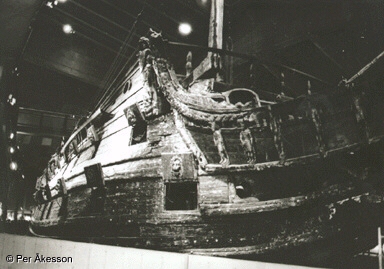
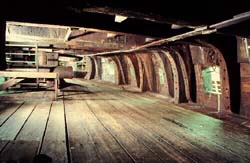
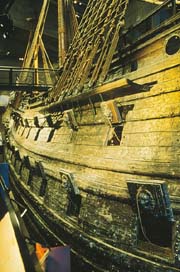
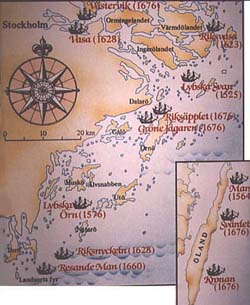
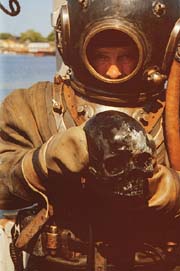
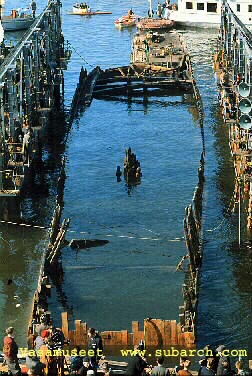 April
24, 1961, 9:03 am, the media recorded a piece of ancient black oak breaking the surface of the
water, followed by 2 rows of bulwark stanchions. The damaged super-structure had finally come into
view. The threesome flotilla was moved to shallower water where Swedish-invented B-200L submersible
equipment was deployed to pump out water from Vasa's hull faster than water was leaking into her.
She began to rise, after 333 years of submergence. Flygt submersible pumps kept her afloat in
harbor and sprayed her entirely with water for 2 weeks, 24 hrs a day, while underwater, frogmen
corked any more leaks. Vasa had to make the last 100 yards into a narrow dock afloat on her own
keel, as there was no room for the 2 pontoons. She was indeed afloat, if listing to port a bit and
was gently hauled in. "The 6 year long adventure of winning back the Vasa was over"
(Saunders 1962:70). Now the work of restoration and preservation could begin.
April
24, 1961, 9:03 am, the media recorded a piece of ancient black oak breaking the surface of the
water, followed by 2 rows of bulwark stanchions. The damaged super-structure had finally come into
view. The threesome flotilla was moved to shallower water where Swedish-invented B-200L submersible
equipment was deployed to pump out water from Vasa's hull faster than water was leaking into her.
She began to rise, after 333 years of submergence. Flygt submersible pumps kept her afloat in
harbor and sprayed her entirely with water for 2 weeks, 24 hrs a day, while underwater, frogmen
corked any more leaks. Vasa had to make the last 100 yards into a narrow dock afloat on her own
keel, as there was no room for the 2 pontoons. She was indeed afloat, if listing to port a bit and
was gently hauled in. "The 6 year long adventure of winning back the Vasa was over"
(Saunders 1962:70). Now the work of restoration and preservation could begin.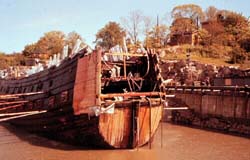
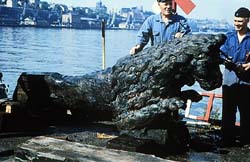
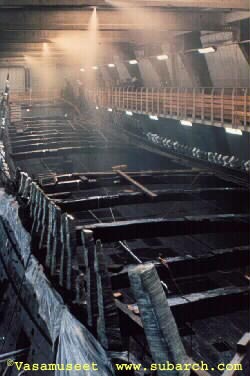 Exposed
timbers would quickly crack in sunlight and air so archaeologists had to prevent this urgently.
They wrapped beams and stanchions in plastic sheets. The king at that time, King Gustav VI Adolph,
was an archaeologist and prime supporter of the recovery program. Once the upper gun deck was
completely excavated then they gained access to the lower gun deck (or the dead men's deck). This
deck had a low ceiling and today's tall Swedes had to bend while working inside it. It was quite a
task to sort out particles of interest in the grim machinery of a fighting man-o'-war. There was
perhaps over a 100 tons of stuff, all covered in mud.
Exposed
timbers would quickly crack in sunlight and air so archaeologists had to prevent this urgently.
They wrapped beams and stanchions in plastic sheets. The king at that time, King Gustav VI Adolph,
was an archaeologist and prime supporter of the recovery program. Once the upper gun deck was
completely excavated then they gained access to the lower gun deck (or the dead men's deck). This
deck had a low ceiling and today's tall Swedes had to bend while working inside it. It was quite a
task to sort out particles of interest in the grim machinery of a fighting man-o'-war. There was
perhaps over a 100 tons of stuff, all covered in mud.  Ships'
timbers on exposure to air must be kept wet if drying and distortion is to be avoided. Direct
wetting is required. And keeping the wood cool and dark is important. For the majority of large
wooden material, some form of water spray system is the most feasible and economic solution (Clark
1987:201). PEG impregnation is currently the most widely used conservation method for waterlogged
wood of all dimensions (Clark 1987:204). Surface application of PEG is done by hand-spraying or
brushing. PEG is non-toxic, needs no extensive safety measures, relatively cheap and available
worldwide. The disadvantage is that treatment takes a long time. The Vasa has been undergoing
treatment since 1962. The treatment time perhaps could have been shortened if the hull had been
completely enclosed and protected and the public not allowed access to view the ship (Clark
1987:205).
Ships'
timbers on exposure to air must be kept wet if drying and distortion is to be avoided. Direct
wetting is required. And keeping the wood cool and dark is important. For the majority of large
wooden material, some form of water spray system is the most feasible and economic solution (Clark
1987:201). PEG impregnation is currently the most widely used conservation method for waterlogged
wood of all dimensions (Clark 1987:204). Surface application of PEG is done by hand-spraying or
brushing. PEG is non-toxic, needs no extensive safety measures, relatively cheap and available
worldwide. The disadvantage is that treatment takes a long time. The Vasa has been undergoing
treatment since 1962. The treatment time perhaps could have been shortened if the hull had been
completely enclosed and protected and the public not allowed access to view the ship (Clark
1987:205). 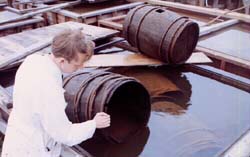
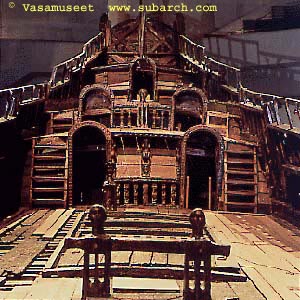 The
aim of The Vasa Project is to present the ship in its original condition for public display. Most
of the Vasa ship underwent extensive preservation. The destroyed portions of the ship, the main
deck, the sterncastle, the bow of the ship and the fitments inside the ship had to be rebuilt. This
work was undertaken by ship technicians, shipwrights, and museum staff, using the original timbers
and parts of the structure. It was being restored in a similar manner to that of the warship
Elefanten, another Swedish wreck.
The
aim of The Vasa Project is to present the ship in its original condition for public display. Most
of the Vasa ship underwent extensive preservation. The destroyed portions of the ship, the main
deck, the sterncastle, the bow of the ship and the fitments inside the ship had to be rebuilt. This
work was undertaken by ship technicians, shipwrights, and museum staff, using the original timbers
and parts of the structure. It was being restored in a similar manner to that of the warship
Elefanten, another Swedish wreck. 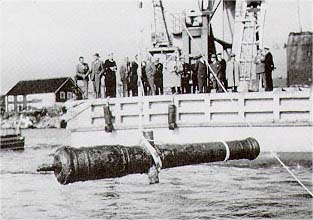
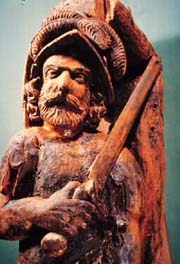
 Back to Nordic Underwater Archaeology
Back to Nordic Underwater Archaeology